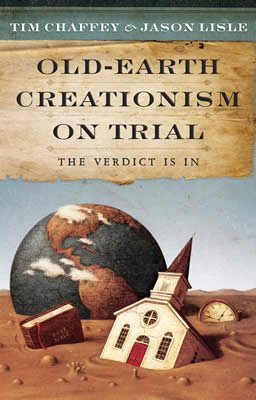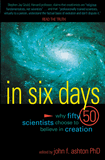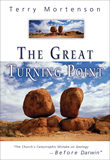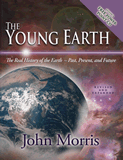
Chapter 2
Prosecution—Biblical Age for the Earth
Welcome to the trial of the century, or better, the trial of the last three centuries.
Welcome to the trial of the century, or better, the trial of the last three centuries. This particular battle has been raging since the early 19th century. Arguments have been promoted in every conceivable media outlet: newspapers, books, magazines, the Internet, television, and video programs. Hopefully, after examining the arguments, the reader will see that there can only be one correct interpretation of Genesis 1–11. That interpretation is known as young-earth creationism.1 Consider the following summary of the young-earthers’ major arguments.
The Plain Teaching of Scripture
Young-earth creationists have argued that their position is the clear teaching of God’s Word. The Bible teaches that God created everything in six days, and that Adam was created on the sixth day. The genealogies recorded in Scripture indicate that Abraham lived about 2,000 years after Adam was created. And since Abraham lived about 4,000 years ago, this means the earth is about 6,000 years old. The earth could be much older if and only if there were substantial gaps in the genealogies, or if God had taken much longer than six days to create. One young-earther put it this way:
Taking Genesis 1 in this way, at face value, without doubt it says that God created the universe, the earth, the sun, moon and stars, plants and animals, and the first two people within six ordinary (approximately 24-hour) days. Being really honest, you would have to admit that you could never get the idea of millions of years from reading this passage.2
This statement offers an accurate summary of the young-earthers’ claims on this point. The Bible should be allowed to speak for itself. If it states that God made everything in six literal days, then it does not matter that the majority of scientists disagree with it.
Some old-earthers admit that this is a major strength of young-earth creationism but still adhere to an old-earth interpretation because of their acceptance of modern scientific theories concerning the age of the earth. Biology Professor Pattle Pun of Wheaton College stated:
It is apparent that the most straightforward understanding of Genesis, without regard to the hermeneutical considerations suggested by science, is that God created the heavens and the earth in six solar days, that man was created on the sixth day, and that death and chaos entered the world after the fall of Adam and Eve, and that all fossils were the result of the catastrophic deluge that spared only Noah’s family and the animals therewith.3
Pun is not alone in making this type of claim. The late Dr. Gleason Archer, an Old Testament scholar, wrote:
From a superficial reading, the impression received is that the entire creative process took place in six twenty-four hour days. If this was the true intent of the Hebrew author (a questionable deduction, as will be presently shown), this seems to run counter to modern scientific research, which indicates that the planet Earth was created several billion years ago.4
Notice that both of these men agree that the plain reading of the text is that God created everything in six ordinary days. It is only because of the “hermeneutical considerations suggested by science” that they will not accept the plain words of Scripture. This is a dangerous approach to the Bible and will be dealt with later.
In addition to this concept of the plain reading of the text, young-earth creationists point to Exodus 20:11.
For in six days the Lord made the heavens and the earth, the sea, and all that is in them, and rested the seventh day. Therefore the Lord blessed the Sabbath day and hallowed it.
This passage is found in the midst of the Ten Commandments. God told the Israelites that the reason they were supposed to work six days and rest on the seventh is because that is precisely what He did during the creation week. Some old-earth creationists interpret each of the days of creation as long ages (many millions of years each), rather than ordinary days. But Exodus 20:11 precludes this possibility. It would be silly to think that we are supposed to work for six long ages (millions of years each) and then rest for one long age. This statement is repeated in Exodus 31:17 and in this passage we are told that God wrote the words himself. It is important to point out that the word used for “day” in these passages is the same as the word used in Genesis 1.
“Yom” in Context
This brings us to the next argument. A major point of contention centers on the definition of the word day in Genesis 1 and 2. Just like the English word “day,” the Hebrew word yom (יום) can refer to the daylight portion of a day, a 24-hour period, or an indefinite period of time. The proper interpretation is dependent upon context and is usually not too difficult to discern. This is true even when the same word is used multiple times in the same passage. To illustrate this point, we could make this statement, “Back in my grandfather’s day, it took ten days to drive across America during the day.” It is easy to understand how the word “day” is used in all three instances. Why is it that no theologian disputes whether the Israelites marched around Jericho for seven days or seven thousand years? It is because the particular context demands that yom in Joshua 6:14–15 is referring to a 24-hour time period.
- Cardinal number
- The name given to number words (one, two, three, etc.).
- Ordinal number
- A number designating a place in a numbered sequence (first, second, third, etc.).
Young-earth creationists often point out that every time yom is paired with the words “evening” or “morning,” it refers to an ordinary day. For that matter, the phrase “evening and morning” by itself would constitute an ordinary day. When the word “night” is paired with yom, it also refers to an ordinary day. Whenever yom is used in the Old Testament with either a cardinal number or an ordinal number, it always means a literal day. In Genesis 1, yom appears with a cardinal number on the first day and with ordinal numbers on the second through sixth days. It also appears with the words “evening” and “morning” on all six days and the word “night” on the first day. Any one of these contextual clues would be sufficient to indicate that the days of creation are ordinary days. Yet, Genesis 1 uses all of them. It seems as if God really stressed this fact to make sure we understand the days are literal, ordinary days.
Genealogical Evidence
Since Adam was created just days after the earth, the length of time between the creation of Adam and today is the approximate age of the earth. A natural reading of the biblical genealogies reveals that the earth could not be billions of years old. Genesis 5 gives a record from Adam to Noah, and Genesis 11 provides the line from Noah to Abraham. Scholars generally agree that Abraham lived around 2000 B.C. The genealogies of Genesis 5 and 11 add roughly another 2,000 years. When one adds the 2,000 years since Christ, we get an age for the earth of about 6,000 years. The old-earther is forced to try to insert numerous gaps into the text when there is strong evidence against such gaps. (For a more thorough discussion of this subject please see Appendix C.) Even if such gaps existed, they couldn’t involve more than a few thousand years without making the genealogies meaningless and ludicrous. They certainly would not allow for the billions of years to be inserted. So adding gaps does not harmonize the Bible with old-earth geological and cosmological theories.
Death and Suffering before Sin
Young-earth creationists also point to several theological difficulties and contradictions created when one attempts to insert vast ages into the Genesis record. The most serious error is that this practice necessarily places death, disease, and bloodshed before sin. If there are fossils that are hundreds of millions of years old (as old-earthers believe), then those animals must have died before Adam sinned (since we all agree that Adam was not around millions of years ago). Some fossils have evidence of disease in them, such as cancer, arthritis, and tooth disease.
By inserting billions of years into the Bible, the old-earth view places death and suffering before sin.
By inserting billions of years into the Bible, the old-earth view places death and suffering before sin (and therefore death and suffering could not be the result of Adam’s sin). In the process, this undermines the foundation of the Gospel message itself. Old-earthers are not being accused of denying the Gospel, but their view necessarily undermines the foundation of the Gospel message. If animal death and bloodshed occurred before sin, then God pronounced these as “very good” in Genesis 1:31. If millions of years had occurred, then the curse pronounced on the animals and the ground (Gen. 3:14 and 3:17) had no effect—there was already animal death and disease and the ground was already producing thorns and thistles. Thorns and thistles are found in fossil layers that old-earth geologists say existed 300–400 million years before man came on the scene.5 Yet, the Bible teaches that thorns and thistles are the result of sin—part of God’s curse on the ground after Adam sinned (Gen. 3:18).
The idea that death existed prior to Adam’s sin is also refuted by the original diets prescribed for both man and animals in Genesis 1:29–30.
And God said, “See, I have given you every herb that yields seed which is on the face of all the earth, and every tree whose fruit yields seed; to you it shall be for food. Also, to every beast of the earth, to every bird of the air, and to everything that creeps on the earth, in which there is life, I have given every green herb for food”; and it was so.
Why would God command a vegetarian diet for all living creatures? The obvious answer is because death was not a part of the original creation. People were not supposed to kill animals and animals were not to kill each other. In some cases, we find fossils of animal parts inside other animals; the fossil record does contain abundant evidence of meat-eating animals. From the Scriptures, we know that this carnivorous behavior among some animals must have come after sin, as a result of the Curse. So, the fossils cannot be millions of years old.
What Does the New Testament Teach?
When Jesus Christ was in His earthly ministry, He confirmed that the earth is young. When questioned by the Pharisees concerning divorce, He replied, “But from the beginning of the creation, God ‘made them male and female’
” (Mark 10:6; Matt. 19:4). The obvious implication here is Jesus knew that Adam and Eve were created “from the beginning.” If billions of years had passed prior to their creation, then Jesus’ claim that Adam and Eve were from the beginning of creation would simply be wrong. The only possible way for our Lord’s response to be accurate is if the days of creation were literal 24-hour days. Adam and Eve were created on the sixth day of the very first week (which would be the beginning from Jesus’ vantage point 4,000 years later)—not 14 billion years after the beginning.
The New Testament contains other similar statements. For example, Romans 1:20 states:
For since the creation of the world His invisible attributes are clearly seen, being understood by the things that are made, even His eternal power and Godhead, so that they are without excuse.
While reading this verse, Christians usually focus on the concept that general revelation reveals God’s attributes (or characteristics). Certainly this is taught here. But there is another interesting point about that general revelation. It states that God’s attributes are clearly seen and understood “since the creation of the world.” This important point cannot be emphasized enough. In order for His attributes to be “clearly seen” and “understood” since the creation of the world, someone had to be there to do the seeing and understanding. This someone does not refer to angels. The entire context of this passage deals with mankind. In other words, Paul is saying that men were around since the beginning of creation, and they were able to clearly see God’s invisible attributes. This is only possible from the young-earth perspective. If billions of years had passed before man came on the scene, then Paul, inspired by the Holy Spirit, was gravely mistaken.
Restoration of Paradise
Isaiah 65:25 prophesied of a peaceful time when “the wolf and the lamb shall feed together” and “the lion shall eat straw like the ox.” This restoration hearkens back to the original creation when all animals were vegetarian (Gen. 1:30). This is problematic for the old-earth creationist because he does not believe that all creatures were originally vegetarian. Recall that evidence of meat-eating creatures is found in the fossil record. Since the old-earther believes these fossils are millions of years old, he is forced to believe that carnivorous activity existed long before the time of Adam. But this runs contrary to Genesis 1:30.
In the future, God will create “a new heaven and a new earth” (Rev. 21:1). To our knowledge, no Christian believes this will take God billions of years to create. Why then insist that it took this long the first time?
Several other theological problems could be listed, as well as scores of scientific difficulties, but these will suffice to give a summary of the young-earth creationist’s major biblical arguments. Also, some of the other young-earth arguments will surface during the next few chapters. It is time to examine the old-earthers’ responses to these points and see if they can stand up to the scrutiny of a biblical cross-examination.
Old-Earth Creationism on Trial
Opting to skirt the controversy of Genesis as literal history, the biblical authority of the Holy Word is called into question and reduced to a collection of mere stories.
Read Online Buy BookFootnotes
- We actually prefer the term “biblical creation,” since our view of origins is determined by strict adherence to a straightforward reading of the Bible. But since we have not yet established this, we will use the term “young-earth” creation to contrast our position with those who hold to “old-earth” creation.
- Ken Ham, ed., The New Answers Book (Green Forest, AR: Master Books, 2006), p. 89.
- P.P.T. Pun, Journal of the American Scientific Affiliation 39:14, 1987.
- Gleason L. Archer, A Survey of Old Testament Introduction (Chicago, IL: Moody, 1985), p. 187.
- Wilson N. Stewart and Gar W. Rothwell, Paleobotany and the Evolution of Plants (Cambridge, UK: Cambridge University Press, 1993), p. 172–176. It shows fossilized thorny plants (Psilophyton crenulatum) found in the Devonian formation, which the evolutionists date at 345–395 million years BP (before present). Also, roses are said to have evolved around 40 million years ago.
Recommended Resources

Answers in Genesis is an apologetics ministry, dedicated to helping Christians defend their faith and proclaim the good news of Jesus Christ.
- Customer Service 800.778.3390
- © 2024 Answers in Genesis





